Urbanization is an irreversible trend in today’s world, accelerating with the continuous growth of the global population. Urbanization alters the distribution and availability of resources, fragmenting habitats for species and affecting the connectivity and suitability of ecosystems. Different species respond to urbanization in vastly different ways: some face extinction risks due to their inability to adapt, while others successfully exploit urban environments, becoming what are known as “urban exploiters.” Understanding these behavioral changes is crucial for predicting species’ survival and adaptability in the context of urbanization.
Previous studies have often focused on the direct impacts of urbanization on animal behavior, such as changes in behavioral responses, but have paid insufficient attention to whether it leads to repeatable inter-individual differences (i.e., behavioral types, BTs; also known as animal personalities). Urban environments may selectively favor certain behavioral types, thereby influencing species’ behavioral traits. For example, animals in urban environments may exhibit higher boldness and aggression, which could be adaptive responses to urban settings.
However, research on how urbanization shapes animals’ spatial behavioral types (spatial-BTs, such as mobility and exploration) is relatively scarce. Spatial behavioral types refer to differences in individuals’ movement patterns and space use, which may reflect their adaptive strategies to the environment. Therefore, studying the impact of urbanization on animals’ spatial behavioral types is significant for understanding urbanization’s effects on biodiversity. This study focuses on the Spur-Winged Lapwing Vanellus spinosus in the Middle East, utilizing high-precision tracking technology to analyze the differences in spatial behavior between urban and rural environments, aiming to reveal the complex effects of urbanization on animal behavior. The research findings, titled Spur-winged lapwings show spatial behavioural types with different mobility and exploration between urban and rural individuals, will be published in January 2025 in the Proceedings of the Royal Society B.

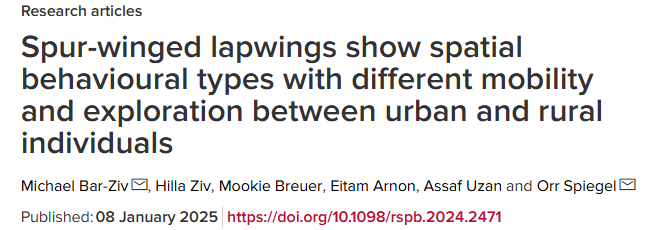
Researchers used the Advanced Tracking and Localization of Animals in real-life Systems (ATLAS) to track 135 Spur-Winged Lapwings, obtaining high-frequency location data to accurately analyze their daily activities. By analyzing metrics such as the duration of stay at activity centers, maximum displacement, and flight distance, combined with principal component analysis (PCA), two main behavioral dimensions were extracted: mobility and exploration-exploitation (ExE). Based on the proportion of urbanization within the individual’s core activity range, individuals were classified as urban or rural types.
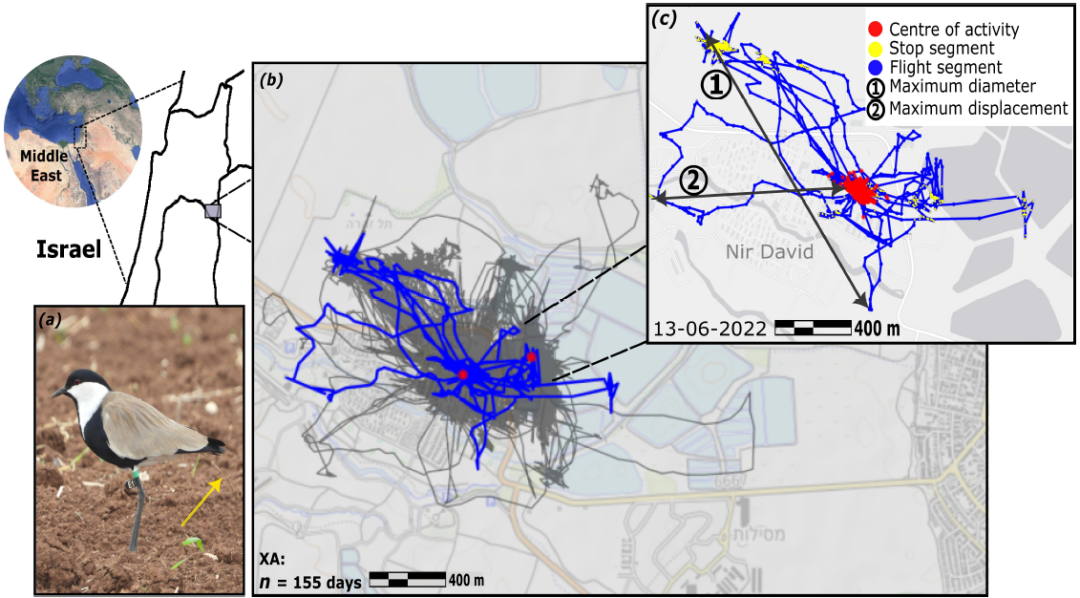
Figure 1 (a) A Spur-Winged Lapwing (Vanellus spinosus) wearing an ATLAS tag, with the yellow arrow indicating the antenna position, and E1 is the flag used for field identification.(b) The activity trajectory of an urban individual (XA, residing in Nir David collective farm) over 155 days (narrow gray line), with the activity trajectory on June 13, 2022, highlighted in blue and enlarged in the inset.(c) Breakdown of the activity trajectory for that specific day and related indices. Yellow and red points represent ground stay points and activity centers (areas where the bird stayed for more than 75% of the total tracking time), respectively. Arrows indicate: (1) maximum daily displacement (the maximum straight-line distance between any two points in one day) and (2) maximum distance from the activity center.
Research found that urban Spur-Winged Lapwings exhibited higher mobility in both seasons (nesting season and non-nesting season), characterized by longer flight distances and broader activity ranges. Urban female individuals were more inclined to exploit during the breeding season (i.e., exploring fewer new areas), while urban male individuals showed a slight opposite trend. The effects of breeding and non-breeding seasons on mobility and ExE were significant, with individual activities during the breeding season constrained by nesting sites, leading to overall reduced exploratory behavior.
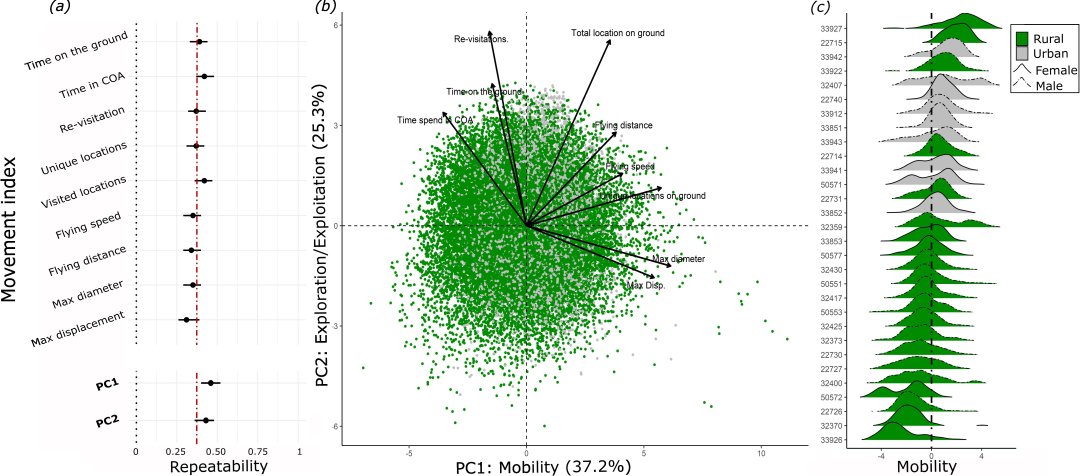
Figure 2 (a) The repeatability values of daily movement metrics for 135 Spur-Winged Lapwings over 26,281 tracking days and their 95% confidence intervals. The figure also includes the repeatability values of the metrics used in the PCA. The repeatability values for PC1 and PC2 are also shown at the bottom. The vertical red dashed line indicates the average R value for BT (0.37).(b) PCA biplot showing the loadings of nine metrics of daily values and daily movement. PC1 (37.2% variance) represents mobility, while PC2 (25.3% variance) represents exploration-exploitation (ExE). Points represent specific days (n > 25,000), colored by habitat.(c) Density plot of individual differences in mobility (PC1) for 30 randomly selected individuals. Color indicates the habitat of the birds, and line type indicates sex. Note that urban birds tend to exhibit higher mobility.
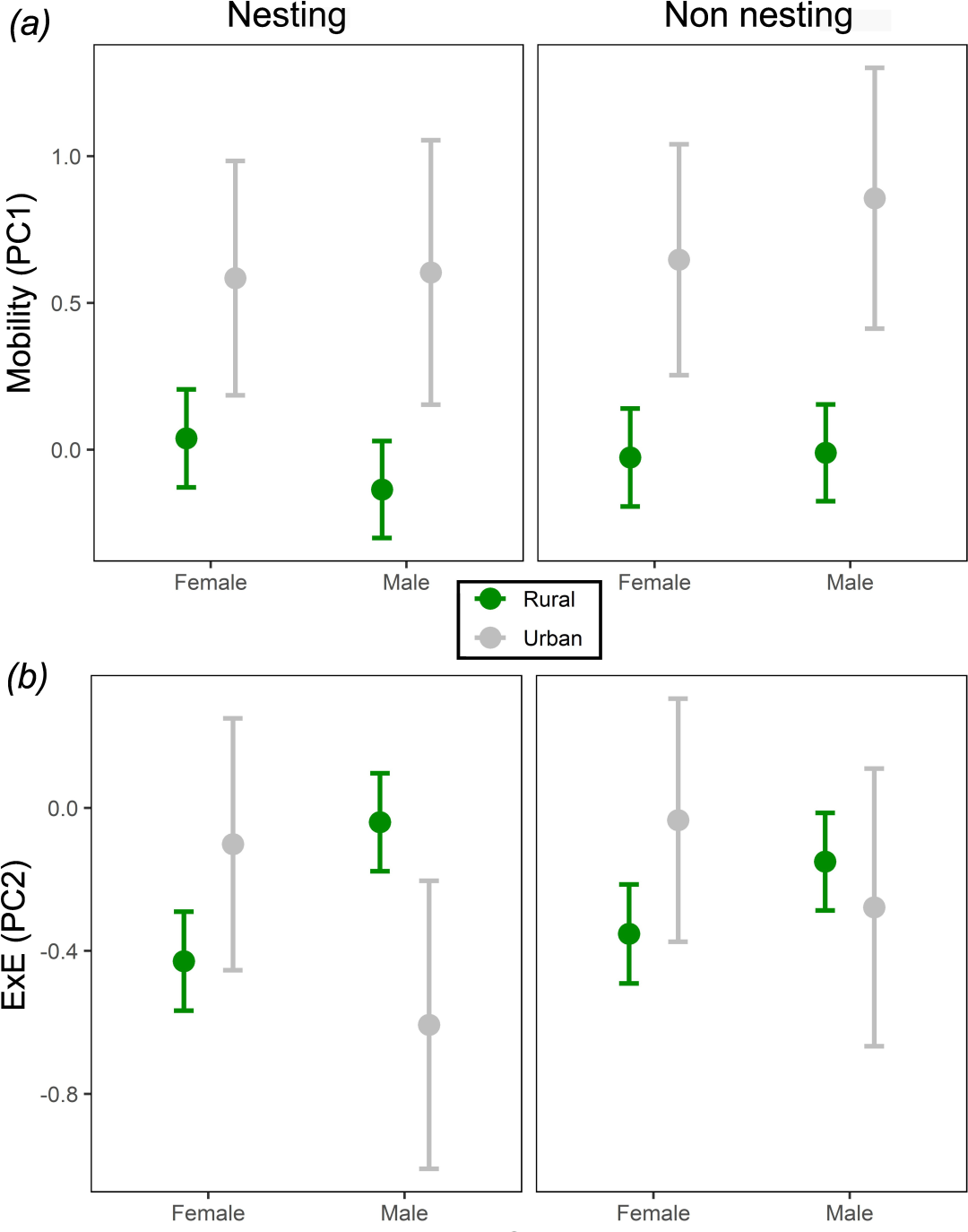
Figure 3 (a) The impact of urbanization status on the mobility principal component (PC1) of Spur-Winged Lapwings. Urban individuals (gray) exhibited higher mobility than rural individuals (green), a trend present in both breeding and non-breeding seasons.(b) The impact of urbanization status on exploration-exploitation (PC2, i.e., ExE) of Spur-Winged Lapwings. Results showed significant interactions between urbanization, sex, and season on ExE. During the breeding season, urban female individuals were more inclined to exploit (i.e., less exploratory behavior), while urban male individuals exhibited a slight opposite trend.
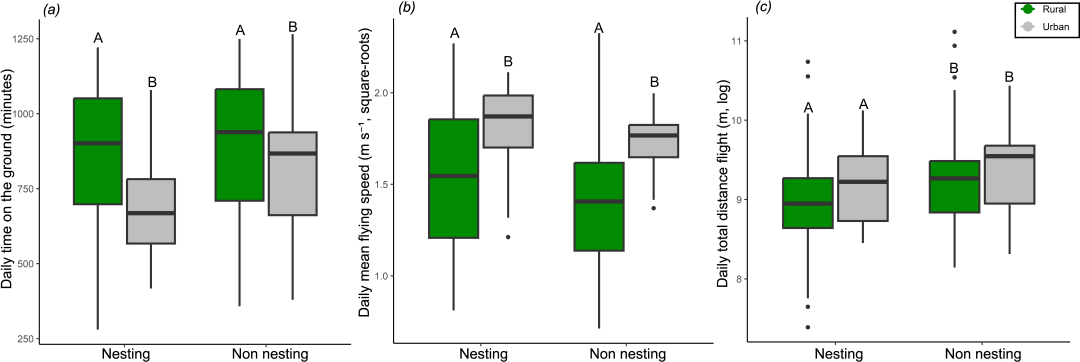
Figure 4 (a) and (b) show significant differences in two specific behaviors between urban and rural Spur-Winged Lapwings. Specifically, urban Spur-Winged Lapwings spent less time on the ground (Figure 4a) and flew faster (Figure 4b). These differences may be attributed to the higher disturbances in urban habitats, leading urban individuals to fly more frequently and spend less time on the ground.(c) shows that Spur-Winged Lapwings traveled longer distances during the non-breeding season. This may be because individuals need to stay near their nests during the breeding season, thus limiting their activity range.
The study indicates that urbanization significantly affects the behavioral patterns of Spur-Winged Lapwings, with urban individuals exhibiting higher mobility and different exploration-exploitation behaviors. These behavioral changes may be adaptive responses to disturbances in urban environments (such as human activities, traffic, etc.) and could impact their energy expenditure and predation risks. Additionally, the study emphasizes the role of high-precision tracking technology in revealing the complexities of animal behavior and suggests that future research should combine experimental and long-term monitoring approaches to gain deeper insights into the potential mechanisms of urbanization on animal behavior.
P.S. The cover image is an artwork generated using Stable Diffusion, not representing the actual appearance and habitat of the experimental animals. The description was generated by Kimi: “an Impressionist oil painting capturing a spur-winged lapwing in mid-flight within an urban park at sunset. Use loose, visible brushstrokes to blend warm oranges and pinks in the sky, contrasting with the earthy browns and soft whites of the bird’s plumage. The background should feature silhouettes of palm trees and distant urban structures, painted with expressive strokes of blue and green to suggest forms rather than define them precisely. The ground below should display dappled shadows and light, achieved through interplay of contrasting colors to evoke sunlight filtering through vegetation. This approach emphasizes the fleeting beauty and delicate coexistence of wildlife and city life.”